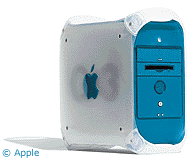The last CRT monitor Apple sold under it's own name was back in
2001. It was the 17" Apple Studio Display featuring an ADC
connector (which means that it only works in a limited number of
Power Mac G4s).
Since then, Apple has concentrated on its line of flat panel
displays and dropped CRT models altogether. This means that if you
want a CRT monitor for your Mac, you have to buy a third-party
one.
If you buy a Dell these days, unless it's the base model chances
are that it's going to come with a flat-panel display, and the same
applies to virtually all major PC manufacturers. The prices of flat
panel displays have dropped enough that they're able to include LCD
displays with all the machines they sell (or at least offer them as
an optional upgrade at a reasonable price).
The prices on Apple's LCD displays have decreased dramatically
since Apple introduced them in 1998.
Apple's first LCD model, a 15" display, sold for $1,999. Just a
year later, the price was down to $1,099. The last 15" LCD display
Apple sold went for $599 in 2002. Apple's least expensive monitor
today is the $999 20" Cinema display, which they mention on their
site is PC compatible (unlike the previous ADC models).
Why would Apple decide to eliminate the bottom-end of their
display lineup? The people who buy iMacs or eMacs already have
displays built into their computers, so they don't need to buy one.
Mac mini buyers are more likely
to use their old display or buy a discounted 17" third party
display.
The reality is that since many non-Apple devices are now Mac
compatible, most people won't be sticking with Apple-branded
peripherals.
 For instance, the monitor I use with my blue Power Mac G3 is a 19" CTX CRT
monitor, which is beige and doesn't match the computer at all. It
doesn't matter, because my speakers are beige, my printer's beige -
and the computer's under the desk anyway, so who's going to notice
what matches and what doesn't?
For instance, the monitor I use with my blue Power Mac G3 is a 19" CTX CRT
monitor, which is beige and doesn't match the computer at all. It
doesn't matter, because my speakers are beige, my printer's beige -
and the computer's under the desk anyway, so who's going to notice
what matches and what doesn't?
There's been a general drive toward pushing LCD monitors, too.
It's a bit like the silver electronics craze that seems to be
present these days. In the 1970s, high-end electronics had metal
faceplates and typically either metal or wooden sides. When the
cheaper electronics started coming with silver faceplates and
(fake) wood sides, the high-end moved to black with an abundance of
LED displays.
That look stayed in for a while, until the low-end was able to
catch up and every $59.99 ghetto blaster (even if it had an
analogue dial) was black. In the past few years, middle and
high-end electronics have moved back to silver (with blue LED's
this time), and the low-end is starting to follow.
For monitors, LCD displays have represented the high-end for a
long time, and size didn't really matter. Now that prices have
begun to drop, size is starting to matter (like it did with CRT
monitors).
- Acer AL1914SMD 19" LCD display, $295
- GEM 17" LCD display, $149
- BenQ 15" LCD display, $140
|
You can get a 19" CRT monitor for under US$200, 17" for US$100, and
the 15" CRT product has moved to the very low end. Apple doesn't
want to be caught making low-end CRT monitors, which could be
bought elsewhere for half the cost, for its high-end systems.
There are benefits to LCD displays. They certainly take up a lot
less space, and they use a lot less energy than even the most
modern energy saver CRT displays, although they cost more. However,
I still have to say that I prefer the image on a CRT.
Although they have improved greatly over the past few years,
LCDs still have a general "sharpness" to the picture that I find
bothers my eyes. It's most likely caused by the larger pixels on
LCD displays, but that may change as LCDs get better.
Who knows, perhaps my next monitor will be an LCD.

 For instance, the monitor I use with my
For instance, the monitor I use with my 
